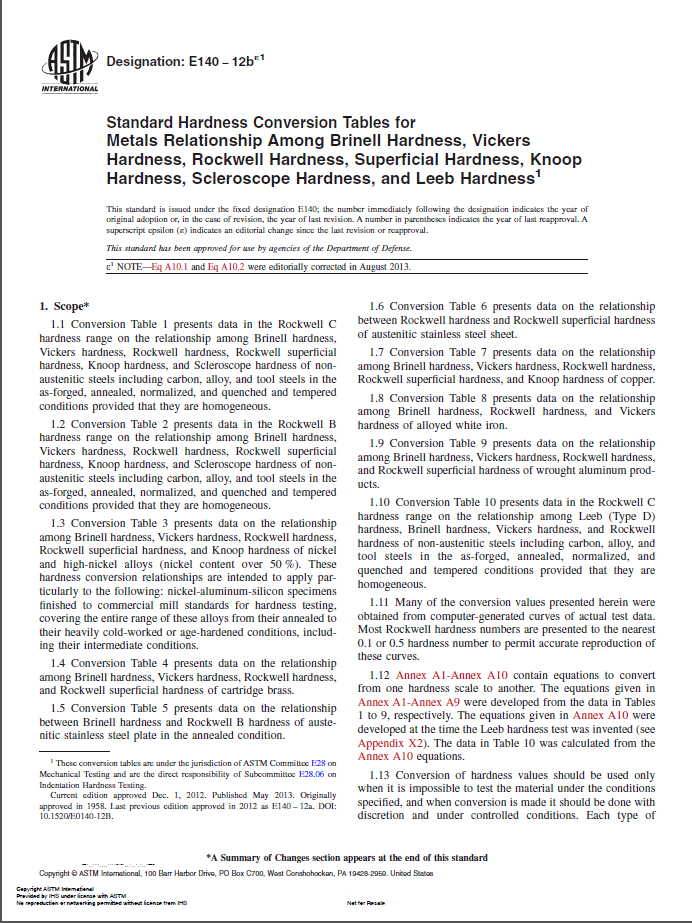ASTM E140-12be1
Standard Hardness Conversion Tables for
Metals Relationship Among Brinell Hardness, Vickers
Hardness, Rockwell Hardness, Superficial Hardness, Knoop
Hardness, Scleroscope Hardness, and Leeb Hardness

This standard is issued under the fixed designation E140; the number immediately following the designation indicates the year of original adoption or, in the case of revision, the year of last revision. A number in parentheses indicates the year of last reapproval. A superscript epsilon (ε) indicates an editorial change since the last revision or reapproval.
This standard has been approved for use by agencies of the Department of Defense.
ε1 NOTE—Eq A10.1 and Eq A10.2 were editorially corrected in August 2013.
标准状态:已作废,被ASTM E140-12替代
1. Scope
1.1 Conversion Table 1 presents data in the Rockwell C
hardness range on the relationship among Brinell hardness,
Vickers hardness, Rockwell hardness, Rockwell superficial
hardness, Knoop hardness, and Scleroscope hardness of nonaustenitic
steels including carbon, alloy, and tool steels in the
as-forged, annealed, normalized, and quenched and tempered
conditions provided that they are homogeneous.
1.2 Conversion Table 2 presents data in the Rockwell B
hardness range on the relationship among Brinell hardness,
Vickers hardness, Rockwell hardness, Rockwell superficial
hardness, Knoop hardness, and Scleroscope hardness of nonaustenitic
steels including carbon, alloy, and tool steels in the
as-forged, annealed, normalized, and quenched and tempered
conditions provided that they are homogeneous.
1.3 Conversion Table 3 presents data on the relationship
among Brinell hardness, Vickers hardness, Rockwell hardness,
Rockwell superficial hardness, and Knoop hardness of nickel
and high-nickel alloys (nickel content over 50 %). These
hardness conversion relationships are intended to apply particularly
to the following: nickel-aluminum-silicon specimens
finished to commercial mill standards for hardness testing,
covering the entire range of these alloys from their annealed to
their heavily cold-worked or age-hardened conditions, including
their intermediate conditions.
1.4 Conversion Table 4 presents data on the relationship
among Brinell hardness, Vickers hardness, Rockwell hardness,
and Rockwell superficial hardness of cartridge brass.
1.5 Conversion Table 5 presents data on the relationship
between Brinell hardness and Rockwell B hardness of austenitic
stainless steel plate in the annealed condition.
1.6 Conversion Table 6 presents data on the relationship
between Rockwell hardness and Rockwell superficial hardness
of austenitic stainless steel sheet.
1.7 Conversion Table 7 presents data on the relationship
among Brinell hardness, Vickers hardness, Rockwell hardness,
Rockwell superficial hardness, and Knoop hardness of copper.
1.8 Conversion Table 8 presents data on the relationship
among Brinell hardness, Rockwell hardness, and Vickers
hardness of alloyed white iron.
1.9 Conversion Table 9 presents data on the relationship
among Brinell hardness, Vickers hardness, Rockwell hardness,
and Rockwell superficial hardness of wrought aluminum products.
1.10 Conversion Table 10 presents data in the Rockwell C
hardness range on the relationship among Leeb (Type D)
hardness, Brinell hardness, Vickers hardness, and Rockwell
hardness of non-austenitic steels including carbon, alloy, and
tool steels in the as-forged, annealed, normalized, and
quenched and tempered conditions provided that they are
homogeneous.
1.11 Many of the conversion values presented herein were
obtained from computer-generated curves of actual test data.
Most Rockwell hardness numbers are presented to the nearest
0.1 or 0.5 hardness number to permit accurate reproduction of
these curves.
1.12 Annex A1-Annex A10 contain equations to convert
from one hardness scale to another. The equations given in
Annex A1-Annex A9 were developed from the data in Tables
1 to 9, respectively. The equations given in Annex A10 were
developed at the time the Leeb hardness test was invented (see
Appendix X2). The data in Table 10 was calculated from the
Annex A10 equations.
1.13 Conversion of hardness values should be used only
when it is impossible to test the material under the conditions
specified, and when conversion is made it should be done with
discretion and under controlled conditions. Each type of
hardness test is subject to certain errors, but if precautions are
carefully observed, the reliability of hardness readings made on
instruments of the indentation type will be found comparable.
Differences in sensitivity within the range of a given hardness
scale (for example, Rockwell B) may be greater than between
two different scales or types of instruments. The conversion
values, whether from the tables or calculated from the
equations, are only approximate and may be inaccurate for
specific application.
2. Referenced Documents
2.1 ASTM Standards:
A956 Test Method for Leeb Hardness Testing of Steel
Products
E10 Test Method for Brinell Hardness of Metallic Materials
E18 Test Methods for Rockwell Hardness of Metallic Materials
E29 Practice for Using Significant Digits in Test Data to
Determine Conformance with Specifications
E92 Test Method for Vickers Hardness of Metallic Materials
(Withdrawn 2010)
E384 Test Method for Knoop and Vickers Hardness of
Materials
E448 Practice for Scleroscope Hardness Testing of Metallic
Materials
在线阅读 免费下载







